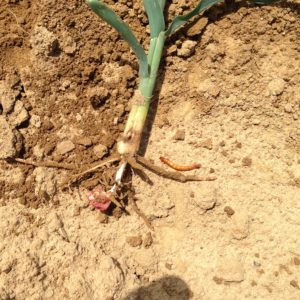Vegetable Crops Edition
Seasonal updates and alerts on insects, diseases, and weeds impacting vegetable crops. New Jersey Commercial Vegetable Production Recommendations updates between annual publication issues are included.
Subscriptions are available via EMAIL and RSS.
Quick Links:
 NJ Commercial Vegetable Production Recommendations
NJ Commercial Vegetable Production Recommendations
 Rutgers Weather Forecasting - Meteorological Information important to commercial agriculture.
Rutgers Weather Forecasting - Meteorological Information important to commercial agriculture.
Increased Online CEUs for Licenses Expiring 2020 – ACT NOW!
Portable Toilets at Farm Markets and Tailgate Markets
 Having a sufficient number of portable toilet facilities and properly cleaning and disinfecting them is even more important with COVID-19. Your labor force may have increased, and your customer volume may be up. You may need to rent additional toilets or have them serviced more frequently if the farm traffic warrants. A good portable toilet company will be prompt and thorough with their servicing and will leave documentation that each unit has been serviced.
Having a sufficient number of portable toilet facilities and properly cleaning and disinfecting them is even more important with COVID-19. Your labor force may have increased, and your customer volume may be up. You may need to rent additional toilets or have them serviced more frequently if the farm traffic warrants. A good portable toilet company will be prompt and thorough with their servicing and will leave documentation that each unit has been serviced.
Between visits from the servicing company, someone on your staff should be trained to clean and disinfect the units at least twice a day. Clean the hard surfaces using a detergent or soap and water followed by rinsing with potable water prior to disinfecting. The Environmental Protection Agency (EPA) maintains a list of disinfectants to use against COVID-19. It is imperative, once you have selected a product, to pay close attention to the contact time on the label which can vary from 1 to 10 minutes. This is the time that the surface MUST remain wet with the product for it to be effective. These disinfectants are for hard surfaces only- do not apply to produce or skin. Wear gloves since these products can irritate the skin.
A household bleach solution can be used to disinfect surfaces. Prepare the solution by mixing 5 tablespoons (1/3 cup) bleach per gallon of water or 4 teaspoons bleach per quart of water. Bleach and disinfectants should be stored in non-clear containers and used within 30 days after opening. Proper ventilation and gloves are necessary when mixing this disinfection solution. For more details on using bleach as a disinfectant please read our earlier Plant and Pest Advisory post. An alcohol solution with at least 70% alcohol can also be used to disinfect.
More Reasons and Some Strong Precautions When Adding Soil Around Transplants on Plastic Mulch
There are a couple of additional reasons you might consider placing soil around the transplant hole when using plastic mulches, but take note – this practice should come with a significant warning label!

This pepper seedling is wilting because the stem is severely burned where it touched the hot plastic mulch.
In addition to reducing heat venting and water pooling that Michelle described in her previous post, one of the first reasons this practice gained popularity among vegetable growers was to prevent the plastic mulch burns on the stems of transplants, especially tomatoes and peppers. On bright sunny days during the transplanting season from late April through June, the temperature of unshaded, black plastic mulch will get hot enough to cause a burn on the stem if touching the transplant. Coupled with wind whipping and rapid transpiration, stem burn can kill a new transplant outright. If the plant does survive, there can be enough damage that later in the season the stem is too weak to support the top growth and the plant topples over.
For that reason, the current Mid-Atlantic Commercial Vegetable Production Recommendations, especially for peppers, is to, “Use opaque, white plastic when planting in the summer [and even late spring] for fall harvest.”
Warning – consider these factors in selecting soil to put around transplants on plastic mulch:
Many growers have learned in the school of hard knocks that this practice can cause some problems as serious as those they were trying to prevent. By trial and error, most have learned that the best soil to put around transplant holes is clean, washed sand from a site other than the field where it is applied, or field soil that has been fumigated the same as the mulched beds.
Why?
- If you fumigate or apply fungicides to the beds to prevent Phytophthora, nematodes and other soil born diseases, putting untreated soil from between the beds puts innoculum right at the base of the susceptible new transplant, defeating the purpose of the fumigation, and maybe making the situation worse because there are no competing beneficial organisms to slow the development of those pathogens.
- Untreated soil from between beds will also contain weed seeds that won’t be controlled by pre-plant herbicides applied under the plastic mulch.
- To make matters worse, even if the soil between the beds was fumigated, if an herbicide was applied before transplanting, concentrating those herbicides at the base of a transplant may not be labeled for that use and likely will be toxic to the transplant.
Dr. Thierry Besancon, Rutgers Extension Weed Specialist for Specialty Crops, identified many herbicides labeled for use on bare soil between plastic beds that he would consider potentially dangerous to the transplants if soil containing these compounds would be added above the planting hole:
- Fomesafen (Reflex): labeled PRE for row middles and under plastic on some crops. Unfortunately, it has also POST activity..
- Pendimethalin (Prowl): labeled ONLY for row middle applications in plasticulture
- Trifluralin (Treflan): labeled ONLY for row middle applications in plasticulture
- Halosulfuron (Sandea): labeled for row middles only. Has both PRE and POST activity which could result in severe crop injury if the herbicide get in contact with the crop.
- Clomazone (Command, Strategy): even if it’s labeled for under plastic and row middles PRE application in some crops, be extremely careful with this herbicide that cannot be applied over emerged plants.
- Metribuzin: only labeled for row middles application in plasticulture – potential risk of injury if soil containing it is used around the hole because it has POST activity
- Rimsulfuron (Matrix): labeled only for row middles with both PRE and POST activity on broadleaf species.
- Terbacil (Sinbar): used PRE under plastic or in row middles, but has POST activity and should never be applied over the crop.
- Ethalfluralin (Curbit): labeled ONLY for row middle applications in plasticulture
Other PRE herbicides such as bensulide (Prefar), napropamide (Devrinol) or s-metolachlor (Dual Magnum) should not cause damage but using soil that has been treated with these products when adding soil around the transplant holes is discouraged as no tests have ever been conducted to make sure this is really safe, essentially because these herbicides are not supposed to be used this way.
Dr. Besancon says, “Actually, the only herbicides I would really feel confident about are the graminicides (Poast, Select) and paraquat: graminicides are only targeting grasses and paraquat will tied up to Organic Matter particles (virtually inactive in the soil).
He also warns that this technique, if using soil from between the mulched beds, disturbs the uniform herbicide distribution in the row middles by creating gaps in the coverage… herbicide-free spaces where weeds will grow! Not disturbing the soil is essential for maintaining the efficacy of PRE herbicides.
Placing soil around the base of new transplants on plastic mulch can protect tender plants from being damaged by heat, water and the plastic itself, saving time and money by reducing the need to replace plants later. Using the right soil for the job will make sure you don’t lose those savings by creating new problems!

IPM Update 5/13/20
Sweet Corn
IPM Program personnel have re-established the black light trap network in New Jersey. With continued below normal temperatures, no corn earworm (CEW) or European corn borer (ECB) moths have been captured. As numbers increase, look for population maps of ECB, CEW, brown marmorated stink bug (BMSB) and CEW catches from pheromone traps in this weekly publication. The resulting full-state maps will include interpretive information.
 With cold, damp conditions dramatically slowing down the growth of seedling corn, wire worms (see photo at left) have the potential to be more of a nuisance than usual. While we don’t often see this problem in sweet corn, it does occasionally happen when wire worms are present and the corn cannot grow quickly enough to become less susceptible to injury. Look for clusters of seedlings that exhibit wilted inner leaves. Wire worms often are discovered by digging up these affected seedlings. The incidence of this damage may be minor, but if growers determine that a field must be replanted, it may be necessary to include an in-furrow soil insecticide targeting this pest.
With cold, damp conditions dramatically slowing down the growth of seedling corn, wire worms (see photo at left) have the potential to be more of a nuisance than usual. While we don’t often see this problem in sweet corn, it does occasionally happen when wire worms are present and the corn cannot grow quickly enough to become less susceptible to injury. Look for clusters of seedlings that exhibit wilted inner leaves. Wire worms often are discovered by digging up these affected seedlings. The incidence of this damage may be minor, but if growers determine that a field must be replanted, it may be necessary to include an in-furrow soil insecticide targeting this pest.
Reasons to Add Soil Around the Transplant/Planting Hole on Plastic Mulch
Plastic mulch has been widely adopted by vegetable growers everywhere. The benefits of plastic mulch and raised beds have proven to improve crop quality and yields.
One practice some growers use, just after transplanting into plastic mulch, is to have workers place a small shovel full of soil around the  base of the plant and enough to seal the hole around the plant. This works best for transplants with tall stems – tomatoes, peppers, eggplants and cole crops.
base of the plant and enough to seal the hole around the plant. This works best for transplants with tall stems – tomatoes, peppers, eggplants and cole crops.
One caution before using this beneficial cultural practice, is to understand the implications of herbicides applied between rows. If a herbicide was applied in row middles that is harmful to the crop planted into the plastic mulch, the transplant could be damaged, stunted or die. Read the herbicide label before using row middle soil to fill in the planting hole. If the row middle soil is safe to apply, then this practice is recommended.
Why is the tedious, time-consuming and laborious task so important?
There are a few reasons.
1. Placing soil around the transplant and planting hole will prevent water from puddling around the plant when significant rainfalls occur. Excessive puddling around the transplant can induce root and crown disease infections.
2. The extra soil will provide support and stability for the plant until roots can anchor the plant in the ground and the plants can be staked and tied.
and tied.
3. By adding soil to seal-over the plastic mulch hole, the seal will prevent “venting” of hot air. This is especially important when plants are young, acclimating to outdoor weather and when hot and sunny days occur shortly after transplanting.
All reasons listed above will be important this week, as the weather conditions for Thursday call for rain in New Jersey and then flowed by temperatures in the 80s. Soil temperatures will rise and more critical, air temperatures under plastic mulch will be much higher than 80 degrees. The hot air venting on young, tender transplants will cause stress and can possibly lead to transplant death.
For these reasons, it is important to fill in and seal those transplant holes.
Labor Will Be Hot Topic For 7:00PM Wednesday Night Webinar – “Ask the Ag Agent”
This week, the webinar will be concentrated on the topic of farm labor. Since updates are coming to the industry and we have learned of some programs for migrant workers please join us for discussion. Please feel free to bring up other topics.
Ask the Ag Agent – 7:00PM Weekly – Every Wednesday – Farmer Video Conference/Call-In Forum
“Ask the Ag Agent” weekly 1-hour sessions for farmers will be hosted again on Wednesday May 13th and continue each Wednesday until May 27th. The online conferencing/call in events will begin at 7:00PM with an open forum to discuss ag-related questions about production, marketing, regulations and any other topics farmers wish to discuss. All are welcome. Events are hosted by William Bamka, Stephen Komar, Meredith Melendez and Michelle Infante-Casella – Agricultural Agents.
To access via WebEx on a computer go to https://go.rutgers.edu/rc9n3kxt
Or, Join by phone
+1-650-429-3300 USA Toll
Access code: 799 743 872
For additional Rutgers Cooperative Extension educational programs check out https://events.rutgers.edu/njaes/
